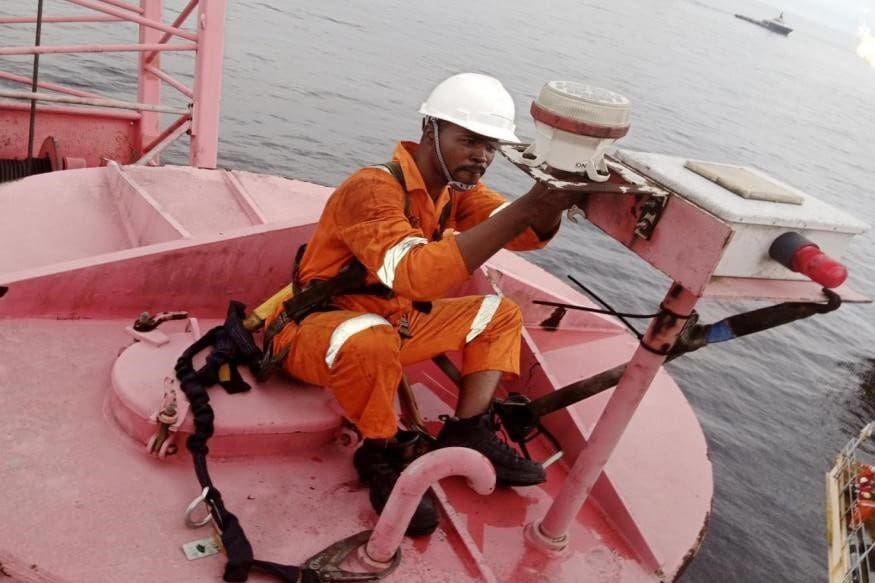Life as an Electro-Technical Officer on a Self-propelled Jack-up vessel
Sylvester Sylvester Onyekachi studied Electrical and Electronics Engineering and started his engineering career at 18 working for Coca‑Cola HBC in Kaduna Nigeria. This was his first practical experience and encouraged him to work as an intern each holiday whilst at university. Sylvester is now an Electro-Technical Officer on a Self-propelled Jack-up vessel and works in the Ebok oilfield in Nigeria. This article focuses on his career and his experience.
Sylvester Sylvester Onyekachi working in the Ebok oilfield in Nigeria and as a part-time YouTuber


Background and experience
What was your first job after graduating?
I got a job with a dredging company as an electrical engineer and was there for a year.
What did that lead to?
After that I started work for GPK Marine Management Service as an engineer in electro technical operations on a self-propelled jack up vessel (lift boat).
Where do you work?
I work on the Ebok oilfield which is offshore in Nigeria’s southeastern oil producing area.
Self-propelled Jack-up vessel
What exactly is a self-propelled Jack-up vessel?
A jack-up vessel is a barge fitted with long support legs that can be raised or lowered. The jack-up is maneuvered (self-propelled) into location with its legs up and the hull floating on the water. Upon arrival at the work location, the legs are jacked down onto the seafloor.


The ship is fitted with high heavy-duty cranes, and we also provide accommodation to the clients during the contract.
Engineers and crew on the ship
Basically, the ship comprises of two departments, Deck and Engine crew.
Deck crew comprises of:
Ordinary sea man
Able seaman
Crane operators
Bosun
Second officer
Chief officer
Captain (Master).
Engine crew comprises of:
Oiler
Third engineer
Second engineer
Chief engineer
Where does the ETO (Electro-Technical Officer) fit in?
You will be surprised where I come in as Electro-Technical officer (ETO).
ETO is the highest rank you can hold as an electrical officer on a ship. You start as an electrician and then the next step is ETO.
Basically, I am in charge of all the electrical equipment onboard. It is my responsibility alone but with a little support from the team of marine engineers on board.


In summary, I am in charge of the electrical, electronic, control and telecommunication equipment on the ship.
Typical day as an ETO (Electro-Technical Officer) on a Self-propelled Jack-up vessel
What is your typical day like?
My regular day starts with breakfast a 6am. After that, the morning toolbox meeting is at 7am.
At the toolbox meeting we:
schedule jobs for the day.
receive details from clients about equipment which is malfunctioning or broken.
Once the meeting is over, I go for my morning inspections at the switch board at the ECR (Engine Control Room) and Cold Room where all fresh food stuff is stored (freezer has to be kept at -19c and the chiller +5c).
After my inspection and PMS (Planned Maintenance Services), I head straight to repairs of faulty electrical equipment.
My lunch break lasts from 11 am to 1pm.
The afternoon is filled with more repairs until 5 pm when I close my shift.
What do you do during your off-duty time?
I try to make some phone calls, browse the internet, and aim to get to sleep by 12am.


Challenges whilst working on a Self-propelled Jack-up vessel
What was your most challenging experience offshore?
As ETO when the internet is down everyone is pointing a finger at you but when the internet is down on a Christmas day everyone is angry.
One Christmas day we had total personnel onboard of 150 men. They had chosen to work offshore to provide for their families and because of that couldn’t spend Christmas with their loved ones.
So, I felt that the least I could do was to ensure that the internet was working well on Christmas day. However, I don’t know what happened, but the internet went off that day.
I had to reconfigure the entire internet system under the pressure of a crew who were becoming increasingly frustrated.
Eventually after four hours the internet started working and everything went back to normal.
YouTuber as well as Self-propelled Jack-up vessel operator
One of Sylvester’s YouTube posts
How to change share load and change over two generators without black out on a ship
Further reading
Simon Fernandez de la Mata, Marine Field Service Manager in Spain.
Field Service Specialist Michiel Lamens keeping offshore cranes working all over the world.
Kevin Chimezie Akparanta a Coiled Tubing Operator at Halliburton.


Responses